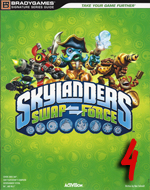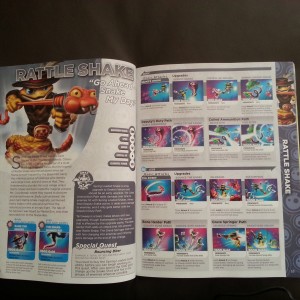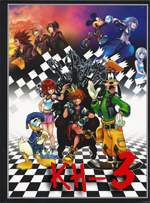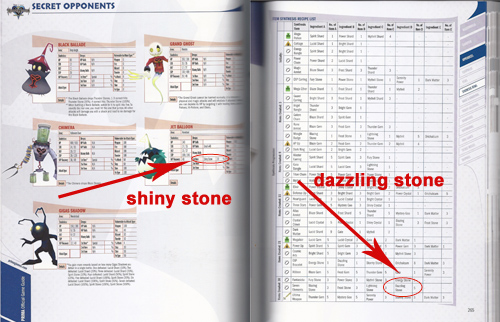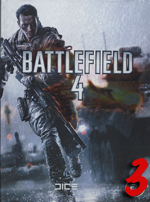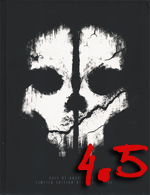 More often than not, shooters have been given the benefit of the doubt when it comes to strategy guide design. Most books have either focused too little on the multiplayer or were so hung up on the multiplayer coverage that the single player campaign was almost neglected entirely. There have been very few that managed to strike a fair balance between the two modes, so upon seeing that BradyGames’ new Call of Duty: Ghosts strategy guide had a decent split, at least in terms of page count, it seemed like an interesting change of pace. Can the most recent outing in Activision’s financial workhorse also yield a rare win for FPS guides as well? Only time will tell…
More often than not, shooters have been given the benefit of the doubt when it comes to strategy guide design. Most books have either focused too little on the multiplayer or were so hung up on the multiplayer coverage that the single player campaign was almost neglected entirely. There have been very few that managed to strike a fair balance between the two modes, so upon seeing that BradyGames’ new Call of Duty: Ghosts strategy guide had a decent split, at least in terms of page count, it seemed like an interesting change of pace. Can the most recent outing in Activision’s financial workhorse also yield a rare win for FPS guides as well? Only time will tell…
If you are a newcomer to the Call of Duty franchise, it is essential to jump into the guide’s first ten pages of what amounts to “FPS 101,” with a significant amount of fervor. However, if you are among the majority of the gaming audience, this is far from your first rodeo. It’s at least important to check and see if the early commentary about general first-person shooter strategy differs from what most might consider to be common sense. Probably the most useful of the lead-in section are the lists and screenshots of each weapon, explaining each of its strong suits. Also, take note that there are no detailed stats like the obligatory refill time, clip size, power, and accuracy in this section, because that is covered exhaustively in the multiplayer rundown.
Without much fanfare, the text abruptly delves into the single-player walkthrough. Consisting of a total of eighty-six pages, the observations should help players better navigate their way through the campaign on the “hardened” difficulty. Once again, it is worth noting that the player may be playing at a lower difficulty, meaning that enemies encountered and general attack strategies may be slightly different.
Each of the game’s eighteen missions (of which some are broken down into sub-missions) start out with a full page, top-down view of the map, along with a call-out section containing the character that the player is controlling, as well as the name of any supporting troops. For those who are new to Call of Duty, understanding who you are controlling is essential to comprehending the story because the perspective jumps around from person-to-person throughout. Also included in many of the mission intros are bullet points of the objectives and the weaponry available at the start.
Within every mission walkthrough, there are several interesting pieces of information that are presented to the reader. For one, special encounter based achievements are spelled out directly in the body of the rundown. Those who have always complained about having to go back and re-play missions in order to accomplish special tasks should finally be silenced. The same actually goes for the in-game collectible, “Rorke Files.” Directly where they would occur within the text of the commentary, it is cut away to, along with a location screenshot as well. This helps keep the flow tight, while also minimizing backtracking. Hopefully more guides will move away from the disjoined call-outs in the margins of a page and instead adopt this approach. In the long run it probably saves the writer time, while also helping to alleviate a player’s frustration. It is a win-win for all parties involved.
The campaign layout itself isn’t that different from what most readers are familiar with. All pages consist of two columns, one larger than the other, punctuated with many, and I mean MANY screenshots. Along with objective specific images, there are also more cinematic shots that are probably meant to provide a better idea of the setting of each mission. In many cases this layout does tend to feel a smidgen claustrophobic, but is mediated by the select few call-outs that are utilized. A useful example of this is the “Know Your Enemy” sections, which are meant to help the reader differentiate between the often similarly dressed adversaries and teammates. Sure, it is silly that these sections actually need to exist from a game design standpoint, but it was nice that the author saw the need and worked to proactively mediate the confusion for the reader.
After the single player mode has been completed, there is always the series’ coveted multiplayer waiting to be conquered. Given that every dudebro under the son is waiting to saw a player’s head off at a moment’s notice, it should go without saying that the more than two hundred pages of coverage should be a must-read for anyone hoping to put up a decent fight. Luckily the “Basic Training” section should be extremely helpful in getting players up to speed on everything from the basics of the mode, down to the more minutia based strategies like proper reloading technique involving both timing and canceling, useful explosive tactics, and how to use cover to its fullest. HUD (heads up display) highlights, effective mini-map use and strategic kill-cam tips are also outlined. Lastly, it wraps up by spelling out changes that have been handed down since previous games, such as adjustments to killstreak bonuses, dynamic map events, and the sharing of field orders between squadmates. All-in-all, even veterans would be better off checking out this section, if for nothing other than seeing the newest updates to the game engine.
If you were worried about the lack of weapon detail in the single player campaign, rest assured that the multiplayer coverage more than makes up for any deficits. There is an impressive total of thirty pages focused on absolutely anything that a player could ever want to know about how the arsenal is tuned. All weapons have their own sections dedicated to each variety of firearm. They even go as far as to include cluster plots, laying out how the spray of repetitive shots will play out over time, grouped by the add-ons that are equipped. Then there are a bevy of bar charts demonstrating things such as how many shots are needed to kill an enemy over assorted distances, variations on the same formula demonstrating how that changes depending upon what firing method is being used (burst fire vs. automatic, and so on…), reload times, and even mag capacities depending upon the add-ons in use. For those that only need a more generalized impression of each class of weapon, there are also simple pro and con lists for all weapons, and generalized traits that are worth understanding. Regardless of the needs of the player, every reader should be impressed with what is easily the most analytically sound weapons section ever compiled in print.
Another extremely key component to achieving online success in all Call of Duty titles is crafting the most complimentary perk package, depending upon a given player’s style of combat. The perks are broken down item-by-item, discussing why it is important and the ways that it can be most efficiently utilized. More importantly, the author also saw fit to explain why certain perks are bad when used by certain play styles. This is ultimately more valuable than knowing the upsides, because it helps newbies become aware of habits that could ultimately lead to their downfall. Lastly, there is a significant amount of time spent discussing the various killstreaks and support drops that are at a player’s disposal. Each individual event, the number of kills needed to unlock the attack, and how it explicitly works is spelled out at a level that only the most dedicated members of the audience would ever want to know. Granted, that isn’t a bad thing by any stretch of the imagination, it just makes for rather dry reading in general.
What follows these impressive walls of technical text is essentially eighty seven pages of pictures. In this case, the pictures are maps of every online multiplayer arena. There are several maps for each stage, showing critical locations in the different game modes, as well as an overhead view with hints as to which weapons should be used at certain locations on the map. At the very least, being able to get an idea of the scale of each location makes looking over each full-page shot ideal for the inner strategist in every soldier.
Wrapping up both the multiplayer coverage and the book as a whole are a bevy of different breakdowns, specific to each online mode. Though this may seem more rudimentary for veterans of former Call of Duties, newer modes like “Kill Confirmed,” as well as “Grind” and “Blitz” are worth looking into, in order to prevent the inevitable making a fool of one’s self. This is then flanked by a pro-tips section that specifically relates to custom class design. Really, this should be more required reading for the target audience, to help prevent from manic trial and error later on down the road. Rounding things out are basic gloss-overs of the “Extinction” stages, as well as general talk about the included Clan Wars metagame. Virtually everything included in this last area are worth looking into for even the most experienced of players.
Judging by the impressive breadth of content covered in the Call of Duty: Ghosts strategy guide, the team over at BradyGames had their hands full. Luckily they were more than up to the task and delivered one of the better FPS guides on the market. The fair balance between single player and multiplayer coverage did a great job of highlighting key concepts, while still providing an insane amount of depth where the need existed. All levels of player will find very valuable information to glean, without feeling like the text is pandering or talking over their head. If you are even considering making the jump to hardcore Call of Duty-dom, this would be a fantastic place to start.
SGR Rating: 4.5/5
Author: Phillip Marcus, Thom Denick, Jason Fox, Rich Hunsinger, Trevor Martin, Arthur Davis, Jon Toney, Daniel Herrera, and Jamison Carroll
Publisher: BradyGames
Editions available: Paperback and Collector’s Edition
Acquired via Publisher

